EVEREST BASE CAMP TREK
“Everest” The Top of the world and Pride of Nepal.
EVEREST BASE CAMP TREK 14 Days/ 13 Nights







Group size:





Max-Altitude:
Arival On:
Meals:
Accomodations:
Program ID:
Departure From:
Destination:
Fitness Level:
Transport Type:
1-10 people
Kathmandu, Nepal
5,550m/10,529ft
Breakfast in Kathmandu. All meals during the trek
3-star hotels in Kathmandu, and teahouses during the trek
Private Vehicles, Domastic Flight
Nepal
Kathmandu, Nepal
Demanding
YNE-071

TRIP INTRODUCTION
Everest basecamp trek is one of the world’s most popular trekking trails. It is Mecca to mountain lovers all over the world. Although the ultimate achievement of this trek is to ascend Kalapatthar “the Everest viewpoint”, there are many other things that all together make this trail a golden trail. The Eastern Himalayan region is home to high mountains like Lhotse, Cho Oyu, Makalu, including Mt. Everest. This is a classic trek that follows in the footsteps of Hillary & Tenzing and ends with an ascent of Kala Patthar for superb views of Everest. The Base camp is just below following the Khumbu Glacier with huge ice pinnacles soaring to unbelievable height.
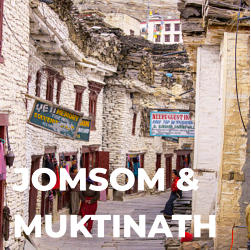
DETAIL ITINERARY
DAY 01: Arrival in Kathmandu:
Arrival in Katmandu. Meeting at the airport and transfer to hotel. A short meeting with our support
team, finalizing permits, and other required documents. As the day is free of any intended tour you
can spend time on your own. Overnight in a hotel.
DAY 02: 25 MINUTES FLIGHT TO LUKLA:
Early flight to Lukla (About 30 minutes) Lukla is a small town located at an elevation of 2500M. soon
as you land at Lukla airport you re-pack and get ready for your first-day trail and you will move
towards Fakding which is about a 2-hour walk from Lukla, trail goes mostly down following
Dudhkoshi River. Overnight in Guest House/Tea house.
DAY 03: TREK TO NAMCHE BAZAR:
The trail up to Namche Bazar is about five hours long with many ups and downs alongside the
Dudhkoshi River the path is full of Nature's beauty, you pass through Sagarmatha National Park,
several villages, and settlements, crossing rivers several times. After a short distance along the Bhote
Koshi, begin the steep ascent to Namche Bazaar. As the mountain path zigzags uphill, you will
emerge at a ridge top rest area that offers excellent views of Everest (8848m) and Lhotse (8516m.).
Namche Bazaar (3440m) is surrounded on three sides by mountain ranges and opens out only
where it faces the Bhote Koshi. The village is a central hub of the area and food, sundries and even
mountain climbing equipment may be purchased here. Overnight in Hotel.
DAY 04: ACCLIMATIZATION IN NAMCHE BAZAR:
Day free in Namche Bazar, for acclimatization for upcoming days. Early morning you can go on a
short hike up to the Everest viewpoint and mountain museum.
Back in the village, there is a lot to do, shopping, observing local life, taking pictures, visiting
monasteries not at all a bad idea if it is a Saturday than traders and venders from nearby villages are
gathering in the town. Overnight in Hotel.
DAY 05: TREK TO TANGBOCHE:
Trek to Tangboche (3867) is about 5 hours walk. You leave Namche Bazar for a climb to the top of a
ridge and level mountain path that offers an excellent panorama of Thamserku, Kantega, and
Kusum Kangri. To the right, there is a cliff that drops down to the Dudh Koshi, faintly visible on the
valley floor below. Make your way around a branch ridge, and Ama Dablam (6812m) Everest, Lhotse,
Nuptse (7855m), and Tawoche (6501m) suddenly appear. After a gentle descent, the mountain path
ends; you will come to the fork leading to Gokyo. Further, you pass Phunki Tenga. It is a long climb to
Tyangboche; in a short while, you come to the stone gate built by lamas which mark your entry into
Tyangboche (3860m). Overnight in a guest house.
DAY 6: TREK TO DINGBOCHE:
It is approximately five hours walk to Dingboche, you walk through the rhododendron forest for few
hours before you reach flat areas having amazing views of Ama Dablam and Kantega (6779m) you
continue walking as they appear on the opposite bank. Climbing gradually up, winding above the
River you get to a big Mani Stupa. Continue the walk is fairly moderate as you enter the Imjatse
Valley on the lab of the gorgeous Ama Dablam, Nuptse, and Lhotse with views of the eastern
snowcapped mountains including the Island Peak (6,189m). Dingboche is a beautiful patchwork of
fields enclosed by stone walls protecting the crops of barley, buckwheat, and potatoes from the cold
winds and grazing animals. Overnight in a guest house.
DAY 07: ACCLIMATIZATION IN DINGBOCHE:
Rest day at Dingboche (4260 m.) for acclimatization. This is a remarkable day for acclimatization.
There are some breathtaking views of the North face of Ama Dablam and the Lhotse-Nuptse ridge
as you explore this beautiful valley that leads up to Island Peak. The walk is short with a good chance
to relax in the afternoon. You have another option as you can hike up to Chhukum. From here you
can enjoy the panoramic view of Island peak, Ama Dablam, Makalu, Tawoche peak, and others.
Overnight in the guesthouse.
DAY 08: TREK TO LOBUCHE:
Trek from Dingboche to Lobuche (4930 m.) is about five hours long. The onward journey leads north
for up to 50-minutes until you come to a mani-prayer Stupa. The trail is gentle looking down to
Pheriche village below, up above it offers views of the Mt.Tawache, Ama Dablam and to the north-
Pokalde (5741m), Kongma-tse (5820m), and the great wall of Nuptse. After two hours walk, the trail
from Pheriche joins near Dugla (4595m) before a small wooden bridge over the river of Khumbu
glacier. You stop at Dugla, for lunch, before continuing for an hour up a steep hill to the top, where
there are views of Mt. Pumori and other peaks west of Everest. After a short break, continue trekking
up to Lobuche, hidden and sheltered from the wind. Overnight in a lodge.
DAY 09: TREK TO EVEREST BASE CAMP:
Trek from Lobuche to Everest Base Camp (5486m.) via Gorakshep (5180m.) Takes about six hours.
Trek up the valley following the rocky moraine path, view icy glacial pond and icebergs down below
of Khumbu glacier. After the last rocky moraine dunes, a short downhill walk brings you to
Gorakshep, the flat field below Kala Patthar (5545m) and Mt. Pumori (7145m.). Now the trail passes
through a rocky path and the Khumbu glacier. The view of Nuptse, Lho-La, and Khumbutse appears
in front of you. Back to the guest house at Gorakshep. Check in to a guest house.
DAY 10: HIKE TO KAKAPATTHAR AND TREK BACK TO FIRICHE:
Trek from Gorakshep to Kala Patthar (5545m.) and trek to Pheriche (4243m.) takes about five hours.
You rise early in the morning, way before the sun, and climb to Kala Patthar (5545m.) which is about
2 hours one way mt. Everest is about 9 KM nautical distance from Kala Patthar you can have a
panoramic view of Mt. Everest and many other mountain peaks like Mt. Pumori, Mt. Lingtren, Mt.
Khumbetse, Mt. Nuptse, Mt. Lhotse, Mt. Ama Dablam, Mt. Thamserku, and many other.
You will descend back to Gorakshep for breakfast and further down to Fireche before the dusk. The
town was once a greater part of the Khumbu glacier which is drained to a mountain village.
Overnight in a lodge.
DAY 11: TREK BACK TO NAMCHE BAZAR:
Trekking back to Namche Bazar from Firiche is a 5-6 hours long, through Tangboche mostly
downhill on the main busy trail with a few steep climbs for an hour from the bridge at Phungitenga,
near to Shanasha. The walk to Namche is very scenic on a long winding path. En- route you will visit
the traditional villages of Khumjung and Khunde. There is an opportunity to visit one of its
monasteries, the only monastery that has a Yeti Scalp still preserved. From Khumjung village,
another 30 minutes walk brings you to the village of Khunde, where you can visit the Khunde
Hospital funded by Sir Edmund Hillary Trust. After Khunde a scenic and pleasant walk brings you to
Namche for an overnight stay.
DAY 12: TREK BACK TO LUKLA:
Trek from Namche Bazaar to Lukla (2886 m.) takes about six hours. The last day of your trek leads
from Namche Bazaar via Monjo to Lukla. The trek is pleasant, except for few short uphill climbs and
then down to the Bhote- Koshi River crossing it three times. The last uphill climb of 45 minutes will
bring you to Lukla for your overnight stay.
DAY 13: FLY TO KATHMANDU:
Fly back to Kathmandu, Transfer to hotel, after a short break you go for a guided tour through the
city, Patan durbar square is the perfect place to be before your final departure. The palace of Patan is
a world heritage site with 14-century Nepali-style temples and a palace. Another place of interest of
the day is Stupa Baudhanath which was a winter shelter for the vendors from Tibet, even today the
majority of the population is migrated from Tibet it is why the area is the so-called “little Tibet”. The
evening atmosphere on the premises is always pleasant and mind captivating. Here visitors and
devotees performing Kora around the stupa. Overnight in Hotel.
DAY 14: FLY OUT FROM NEPAL:
Check out from the hotel at noon. Transfer to airport and departure from Nepal.



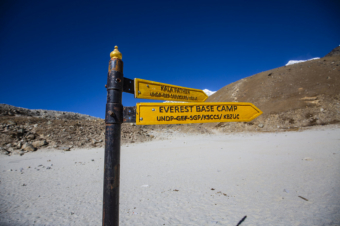
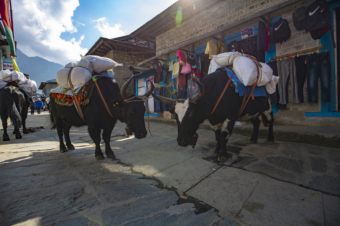
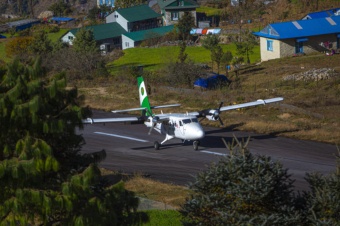
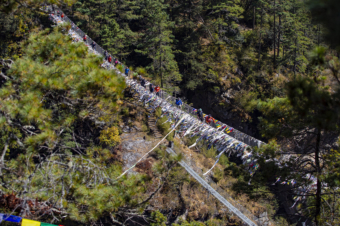
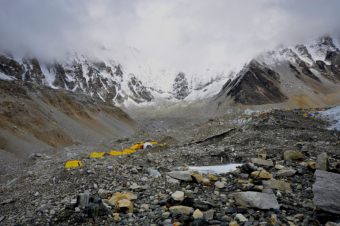
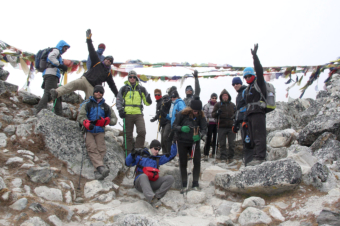
IMPORTANT:
To book the trip required a copy of
passport, 2 passport size
photographs for issuing TIMS
(Tourist Information &
Management System).
Once the Trip has been confirmed
we also need payment of at least
50% of the total amount mostly a
bank transfer. The other half can be
paid before the trip began.
TRIP INFORMATION
THE PRICE INCLUDES:
• Accommodation in 4* hotel in a double room on BB Plan. • Accommodation in best available Lodge (Guest House) during Trek days. • Air flight Kathmandu Lukla & Lukla Kathmandu for Trekkers and supporting team (10Kg. Bag and 5Kg. Hand carry). • A transfer according to the itinerary (airport-hotel) and sightseeing days. • Entrance fees to National Parks, trekking Permits (TIMS) • English speaking Trekking guide according to the itinerary. • Porter 1:2 (One porter for two trekkers) according to the itinerary. • A full board (a breakfast/lunch/dinner - a fixed menu, 3 cups of tea/coffee in the day) during trekking. • First Aid kit and general equipment. • Guide and porter salary • Guide & Porter insurance during the trek • Everest Base Camp Trail Map. • Service coordination of emergency and rescue operations. • Government taxes and office service charges. • A dinner with Nepalese cuisine and traditional dances in Kathmandu. • Achievement certificate. THE PRICE DOES NOT INCLUDE: • Trekking equipment, Sleeping bags, or another type of personal expenses such as Alcoholic Beverage drinks, phones, and Laundry. • Emergency Rescue and any type of Insurance. • Trip cancellation cost, Loss Theft or Damage, and personal effects. • Hot Shower during the trekking days. • The Nepalese visa (on an arrival at the airport): US$40 on persons (30 days) + 2 photos (3х4) • Sleeping bags and other equipment for a Trek. • Lunches and dinners in Katmandu. • All personal expenses and drinks. • Tip: to guides, porters, drivers, etc. • Entrance fees temples and monasteries other than in Kathmandu. • All other expenses which aren't specified in the program • All other expenses at the unconditional situations caused by natural disasters.
PRE-TRIP ESSENTIALS:
HEALTH: A visit to Nepal does not require special vaccination, however, we recommend consulting
with the attending physician and to stock up with necessary drugs before you depart.
Medical services in Nepal are limited in mountainous areas. If you wear glasses, it is better to have at
itself spare couple.
MOUNTAIN SICKNESS: Any person traveling above 2500m can get easy symptoms of a mountain
illness. The first signs are headache, increased fatigue, sleeplessness, appetite loss, liquid loss by an
organism, and puffiness. At the emergence of such signs, it is necessary to remain at this height
before full acclimatization of an organism. It is necessary to use from 2nd to 4 liters of liquid a day. If
symptoms don't pass and the state worsens, it is necessary to go down immediately. Sometimes
even 300m can play a crucial role. Planning the travel, leave spare days on acclimatization at height
3700m and 4300m. After 4000m try not to rise more than 500m in one day. You can inadequately
estimate the condition therefore always follow the advice of the accompanying guide or locals.
WEATHER: Weather conditions on the mountain are unpredictable. It might be sunny during the
day and cold as well as windy at night, especially at the high altitudes. Sudden rainstorms or snow
flurries are always possibilities. Better be prepared!
PACKING: Choosing the right clothing for your trip is very important. You always want to pack
everything, but that could make a hassle. Keep in mind that in almost every mountain region in
Nepal the days are warm and nights are cool. Usually, we recommend people bring a warm jacket
either fleece or down, long underwear, and worm shocks. Pair of pants and comfortable boots for
the long day while sports shoes/sandals for hiking or during the less active period. The boots are
another important factor while on trek make sure that they are waterproof. The basic principle of
packing is comfort not luxury. In Kathmandu and Pokhara you can get any necessary gear at a very
comfortable price.
But if you just enquire before you start packing things we provide you better advice depending
upon present weather conditions. Do not pack unnecessary things like hairdryers, lots of and lots of
cosmetics, and electronics, while a battery power bank (Backup) for your mobile phone, iPod is
recommended.
Another important factor is that the porter/support you hire for the trip has a certain limitation of
how much weight he will carry on his back.
THINGS THAT YOU BEAR: Baggage, backpack you give to a porter shouldn't exceed 15 kg. Your small
backpack for day transitions has to be designed for the most necessary way: the camera, water,
additional clothes on a case of rain or a cold snap, cream from suntan, toilet paper, and other
personal accessories if any.
EMERGENCY AND YOUR SUPPORT TEAM: All our guide are well trained in first aid and can handle
most of the basic illness that occurs at high altitude or in the jungle. Every group is equipped with a
basic first aid kit, every traveler must have full travel insurance before coming to Nepal. And should
make available a copy of the policy at our office in Kathmandu. If an emergency occurs, we will
evacuate you from the mountain to one of the internationally recognized hospitals/clinics in
Kathmandu and contact your insurance company.





Just tell us about your preferences, interests and the amount of time available to you and we will
take care of the rest. We will help design a tour and work out a comfortable itinerary that best suits
your needs.
WHY YANTRA TOURS & TRAVEL?
Yantra Tours & Travel is the Number one guiding cultural/ adventure
travel & tour agency in Nepal. The tour packages we offer to our clients
are very precisely carved to detail and accurate, guaranteed to departure
as scheduled unless there are unforeseen events out of control such as
natural disasters or other restrictions and so on. Read More…



EVEREST BASE CAMP TREK 14 Days/ 13 Nights
© 2020
All material on this web site is subject to copyright
and may not be used without permission.
Design and Maintain By Valley FX
Yantra Tours & Travels Pvt. Ltd.
231/85 Anandnagar Marg, Dhumbarahi, Kathmandu, Nepal
+977 1 44 29 595; +977 1 44 38 270









EVEREST BASE CAMP TREK
“Everest” The Top of the world and Pride of Nepal.

Group size:





Max-Altitude:
Arival On:

Meals:
Accomodations:
Program ID:
Departure From:
Destination:
Fitness Level:
Transport Type:
1-10 people
Kathmandu, Nepal
5,550m/10,529ft
Breakfast in Kathmandu. All meals during the trek
3-star hotels in Kathmandu, and teahouses during the trek
Private Vehicles,
Domastic Flight
Nepal
Kathmandu, Nepal
Demanding
YNE-071
TRIP INTRODUCTION
Everest basecamp trek is one of the world’s most popular trekking trails. It is Mecca to mountain lovers all over the world. Although the ultimate achievement of this trek is to ascend Kalapatthar “the Everest viewpoint”, there are many other things that all together make this trail a golden trail. The Eastern Himalayan region is home to high mountains like Lhotse, Cho Oyu, Makalu, including Mt. Everest. This is a classic trek that follows in the footsteps of Hillary & Tenzing and ends with an ascent of Kala Patthar for superb views of Everest. The Base camp is just below following the Khumbu Glacier with huge ice pinnacles soaring to unbelievable height.
DETAIL ITINERARY
DAY 01: Arrival in Kathmandu:
Arrival in Katmandu. Meeting at the airport and transfer to hotel. A short meeting with our
support team, finalizing permits, and other required documents. As the day is free of any
intended tour you can spend time on your own. Overnight in a hotel.
DAY 02: 25 MINUTES FLIGHT TO LUKLA:
Early flight to Lukla (About 30 minutes) Lukla is a small town located at an elevation of
2500M. soon as you land at Lukla airport you re-pack and get ready for your first-day trail
and you will move towards Fakding which is about a 2-hour walk from Lukla, trail goes
mostly down following Dudhkoshi River. Overnight in Guest House/Tea house.
DAY 03: TREK TO NAMCHE BAZAR:
The trail up to Namche Bazar is about five hours long with many ups and downs alongside
the Dudhkoshi River the path is full of Nature's beauty, you pass through Sagarmatha
National Park, several villages, and settlements, crossing rivers several times. After a short
distance along the Bhote Koshi, begin the steep ascent to Namche Bazaar. As the
mountain path zigzags uphill, you will emerge at a ridge top rest area that offers excellent
views of Everest (8848m) and Lhotse (8516m.). Namche Bazaar (3440m) is surrounded on
three sides by mountain ranges and opens out only where it faces the Bhote Koshi. The
village is a central hub of the area and food, sundries and even mountain climbing
equipment may be purchased here. Overnight in Hotel.
DAY 04: ACCLIMATIZATION IN NAMCHE BAZAR:
Day free in Namche Bazar, for acclimatization for upcoming days. Early morning you can
go on a short hike up to the Everest viewpoint and mountain museum.
Back in the village, there is a lot to do, shopping, observing local life, taking pictures,
visiting monasteries not at all a bad idea if it is a Saturday than traders and venders from
nearby villages are gathering in the town. Overnight in Hotel.
DAY 05: TREK TO TANGBOCHE:
Trek to Tangboche (3867) is about 5 hours walk. You leave Namche Bazar for a climb to the
top of a ridge and level mountain path that offers an excellent panorama of Thamserku,
Kantega, and Kusum Kangri. To the right, there is a cliff that drops down to the Dudh
Koshi, faintly visible on the valley floor below. Make your way around a branch ridge, and
Ama Dablam (6812m) Everest, Lhotse, Nuptse (7855m), and Tawoche (6501m) suddenly
appear. After a gentle descent, the mountain path ends; you will come to the fork leading
to Gokyo. Further, you pass Phunki Tenga. It is a long climb to Tyangboche; in a short while,
you come to the stone gate built by lamas which mark your entry into Tyangboche
(3860m). Overnight in a guest house.
DAY 6: TREK TO DINGBOCHE:
It is approximately five hours walk to Dingboche, you walk through the rhododendron
forest for few hours before you reach flat areas having amazing views of Ama Dablam and
Kantega (6779m) you continue walking as they appear on the opposite bank. Climbing
gradually up, winding above the River you get to a big Mani Stupa. Continue the walk is
fairly moderate as you enter the Imjatse Valley on the lab of the gorgeous Ama Dablam,
Nuptse, and Lhotse with views of the eastern snowcapped mountains including the Island
Peak (6,189m). Dingboche is a beautiful patchwork of fields enclosed by stone walls
protecting the crops of barley, buckwheat, and potatoes from the cold winds and grazing
animals. Overnight in a guest house.
DAY 07: ACCLIMATIZATION IN DINGBOCHE:
Rest day at Dingboche (4260 m.) for acclimatization. This is a remarkable day for
acclimatization. There are some breathtaking views of the North face of Ama Dablam and
the Lhotse-Nuptse ridge as you explore this beautiful valley that leads up to Island Peak.
The walk is short with a good chance to relax in the afternoon. You have another option as
you can hike up to Chhukum. From here you can enjoy the panoramic view of Island peak,
Ama Dablam, Makalu, Tawoche peak, and others. Overnight in the guesthouse.
DAY 08: TREK TO LOBUCHE:
Trek from Dingboche to Lobuche (4930 m.) is about five hours long. The onward journey
leads north for up to 50-minutes until you come to a mani-prayer Stupa. The trail is gentle
looking down to Pheriche village below, up above it offers views of the Mt.Tawache, Ama
Dablam and to the north-Pokalde (5741m), Kongma-tse (5820m), and the great wall of
Nuptse. After two hours walk, the trail from Pheriche joins near Dugla (4595m) before a
small wooden bridge over the river of Khumbu glacier. You stop at Dugla, for lunch, before
continuing for an hour up a steep hill to the top, where there are views of Mt. Pumori and
other peaks west of Everest. After a short break, continue trekking up to Lobuche, hidden
and sheltered from the wind. Overnight in a lodge.
DAY 09: TREK TO EVEREST BASE CAMP:
Trek from Lobuche to Everest Base Camp (5486m.) via Gorakshep (5180m.) Takes about six
hours. Trek up the valley following the rocky moraine path, view icy glacial pond and
icebergs down below of Khumbu glacier. After the last rocky moraine dunes, a short
downhill walk brings you to Gorakshep, the flat field below Kala Patthar (5545m) and Mt.
Pumori (7145m.). Now the trail passes through a rocky path and the Khumbu glacier. The
view of Nuptse, Lho-La, and Khumbutse appears in front of you. Back to the guest house
at Gorakshep. Check in to a guest house.
DAY 10: HIKE TO KAKAPATTHAR AND TREK BACK TO FIRICHE:
Trek from Gorakshep to Kala Patthar (5545m.) and trek to Pheriche (4243m.) takes about
five hours. You rise early in the morning, way before the sun, and climb to Kala Patthar
(5545m.) which is about 2 hours one way mt. Everest is about 9 KM nautical distance from
Kala Patthar you can have a panoramic view of Mt. Everest and many other mountain
peaks like Mt. Pumori, Mt. Lingtren, Mt. Khumbetse, Mt. Nuptse, Mt. Lhotse, Mt. Ama
Dablam, Mt. Thamserku, and many other.
You will descend back to Gorakshep for breakfast and further down to Fireche before the
dusk. The town was once a greater part of the Khumbu glacier which is drained to a
mountain village. Overnight in a lodge.
DAY 11: TREK BACK TO NAMCHE BAZAR:
Trekking back to Namche Bazar from Firiche is a 5-6 hours long, through Tangboche
mostly downhill on the main busy trail with a few steep climbs for an hour from the bridge
at Phungitenga, near to Shanasha. The walk to Namche is very scenic on a long winding
path. En- route you will visit the traditional villages of Khumjung and Khunde. There is an
opportunity to visit one of its monasteries, the only monastery that has a Yeti Scalp still
preserved. From Khumjung village, another 30 minutes walk brings you to the village of
Khunde, where you can visit the Khunde Hospital funded by Sir Edmund Hillary Trust.
After Khunde a scenic and pleasant walk brings you to Namche for an overnight stay.
DAY 12: TREK BACK TO LUKLA:
Trek from Namche Bazaar to Lukla (2886 m.) takes about six hours. The last day of your
trek leads from Namche Bazaar via Monjo to Lukla. The trek is pleasant, except for few
short uphill climbs and then down to the Bhote- Koshi River crossing it three times. The
last uphill climb of 45 minutes will bring you to Lukla for your overnight stay.
DAY 13: FLY TO KATHMANDU:
Fly back to Kathmandu, Transfer to hotel, after a short break you go for a guided tour
through the city, Patan durbar square is the perfect place to be before your final departure.
The palace of Patan is a world heritage site with 14-century Nepali-style temples and a
palace. Another place of interest of the day is Stupa Baudhanath which was a winter
shelter for the vendors from Tibet, even today the majority of the population is migrated
from Tibet it is why the area is the so-called “little Tibet”. The evening atmosphere on the
premises is always pleasant and mind captivating. Here visitors and devotees performing
Kora around the stupa. Overnight in Hotel.
DAY 14: FLY OUT FROM NEPAL:
Check out from the hotel at noon. Transfer to airport and departure from Nepal.









TRIP INFORMATION
THE PRICE INCLUDES:
• Accommodation in 4* hotel in a double room on BB Plan. • Accommodation in best available Lodge (Guest House) during Trek days. • Air flight Kathmandu Lukla & Lukla Kathmandu for Trekkers and supporting team (10Kg. Bag and 5Kg. Hand carry). • A transfer according to the itinerary (airport-hotel) and sightseeing days. • Entrance fees to National Parks, trekking Permits (TIMS) • English speaking Trekking guide according to the itinerary. • Porter 1:2 (One porter for two trekkers) according to the itinerary. • A full board (a breakfast/lunch/dinner - a fixed menu, 3 cups of tea/coffee in the day) during trekking. • First Aid kit and general equipment. • Guide and porter salary • Guide & Porter insurance during the trek • Everest Base Camp Trail Map. • Service coordination of emergency and rescue operations. • Government taxes and office service charges. • A dinner with Nepalese cuisine and traditional dances in Kathmandu. • Achievement certificate. THE PRICE DOES NOT INCLUDE: • Trekking equipment, Sleeping bags, or another type of personal expenses such as Alcoholic Beverage drinks, phones, and Laundry. • Emergency Rescue and any type of Insurance. • Trip cancellation cost, Loss Theft or Damage, and personal effects. • Hot Shower during the trekking days. • The Nepalese visa (on an arrival at the airport): US$40 on persons (30 days) + 2 photos (3х4) • Sleeping bags and other equipment for a Trek. • Lunches and dinners in Katmandu. • All personal expenses and drinks. • Tip: to guides, porters, drivers, etc. • Entrance fees temples and monasteries other than in Kathmandu. • All other expenses which aren't specified in the program • All other expenses at the unconditional situations caused by natural disasters.
PRE-TRIP ESSENTIALS:
HEALTH: A visit to Nepal does not require special vaccination, however, we recommend
consulting with the attending physician and to stock up with necessary drugs before you
depart.
Medical services in Nepal are limited in mountainous areas. If you wear glasses, it is better
to have at itself spare couple.
MOUNTAIN SICKNESS: Any person traveling above 2500m can get easy symptoms of a
mountain illness. The first signs are headache, increased fatigue, sleeplessness, appetite
loss, liquid loss by an organism, and puffiness. At the emergence of such signs, it is
necessary to remain at this height before full acclimatization of an organism. It is necessary
to use from 2nd to 4 liters of liquid a day. If symptoms don't pass and the state worsens, it
is necessary to go down immediately. Sometimes even 300m can play a crucial role.
Planning the travel, leave spare days on acclimatization at height 3700m and 4300m. After
4000m try not to rise more than 500m in one day. You can inadequately estimate the
condition therefore always follow the advice of the accompanying guide or locals.
WEATHER: Weather conditions on the mountain are unpredictable. It might be sunny
during the day and cold as well as windy at night, especially at the high altitudes. Sudden
rainstorms or snow flurries are always possibilities. Better be prepared!
PACKING: Choosing the right clothing for your trip is very important. You always want to
pack everything, but that could make a hassle. Keep in mind that in almost every
mountain region in Nepal the days are warm and nights are cool. Usually, we recommend
people bring a warm jacket either fleece or down, long underwear, and worm shocks. Pair
of pants and comfortable boots for the long day while sports shoes/sandals for hiking or
during the less active period. The boots are another important factor while on trek make
sure that they are waterproof. The basic principle of packing is comfort not luxury. In
Kathmandu and Pokhara you can get any necessary gear at a very comfortable price.
But if you just enquire before you start packing things we provide you better advice
depending upon present weather conditions. Do not pack unnecessary things like
hairdryers, lots of and lots of cosmetics, and electronics, while a battery power bank
(Backup) for your mobile phone, iPod is recommended.
Another important factor is that the porter/support you hire for the trip has a certain
limitation of how much weight he will carry on his back.
THINGS THAT YOU BEAR: Baggage, backpack you give to a porter shouldn't exceed 15 kg.
Your small backpack for day transitions has to be designed for the most necessary way: the
camera, water, additional clothes on a case of rain or a cold snap, cream from suntan, toilet
paper, and other personal accessories if any.
EMERGENCY AND YOUR SUPPORT TEAM: All our guide are well trained in first aid and can
handle most of the basic illness that occurs at high altitude or in the jungle. Every group is
equipped with a basic first aid kit, every traveler must have full travel insurance before
coming to Nepal. And should make available a copy of the policy at our office in
Kathmandu. If an emergency occurs, we will evacuate you from the mountain to one of
the internationally recognized hospitals/clinics in Kathmandu and contact your insurance
company.


Just tell us about your preferences, interests and the amount of time available to you and
we will take care of the rest. We will help design a tour and work out a comfortable
itinerary that best suits your needs.
EVEREST BASE CAMP
TREK 14 Days/ 13 Nights
© 2020
All material on this web site is subject to copyright and may
not be used without permission.
Design and Maintain By Valley FX
Yantra Tours & Travels Pvt. Ltd.
231/85 Anandnagar Marg, Dhumbarahi,Kathmandu, Nepal
+977 1 44 29 595; +977 1 44 38 270









EVEREST BASE
CAMP TREK
“Everest” The Top of the world and Pride of
Nepal.

Group size:





Max-Altitude:
Arival On:

Meals:
Accomodations:
Program ID:
Departure From:
Destination:
Fitness Level:
Transport Type:
1-10 people
Kathmandu, Nepal
5,550m/10,529ft
Breakfast in Kathmandu. All
meals during the trek
3-star hotels in Kathmandu,
and teahouses during the
trek
Private Vehicles, Domastic Flight
Nepal
Kathmandu, Nepal
Demanding
YNE-071




TRIP INTRODUCTION
Everest basecamp trek is one of the world’s most popular trekking trails. It is Mecca to mountain lovers all over the world. Although the ultimate achievement of this trek is to ascend Kalapatthar “the Everest viewpoint”, there are many other things that all together make this trail a golden trail. The Eastern Himalayan region is home to high mountains like Lhotse, Cho Oyu, Makalu, including Mt. Everest. This is a classic trek that follows in the footsteps of Hillary & Tenzing and ends with an ascent of Kala Patthar for superb views of Everest. The Base camp is just below following the Khumbu Glacier with huge ice pinnacles soaring to unbelievable height.
DETAIL ITINERARY
DAY 01: Arrival in Kathmandu:
Arrival in Katmandu. Meeting at the airport and
transfer to hotel. A short meeting with our support
team, finalizing permits, and other required
documents. As the day is free of any intended tour
you can spend time on your own. Overnight in a hotel.
DAY 02: 25 MINUTES FLIGHT TO LUKLA:
Early flight to Lukla (About 30 minutes) Lukla is a
small town located at an elevation of 2500M. soon as
you land at Lukla airport you re-pack and get ready for
your first-day trail and you will move towards Fakding
which is about a 2-hour walk from Lukla, trail goes
mostly down following Dudhkoshi River. Overnight in
Guest House/Tea house.
DAY 03: TREK TO NAMCHE BAZAR:
The trail up to Namche Bazar is about five hours long
with many ups and downs alongside the Dudhkoshi
River the path is full of Nature's beauty, you pass
through Sagarmatha National Park, several villages,
and settlements, crossing rivers several times. After a
short distance along the Bhote Koshi, begin the steep
ascent to Namche Bazaar. As the mountain path
zigzags uphill, you will emerge at a ridge top rest area
that offers excellent views of Everest (8848m) and
Lhotse (8516m.). Namche Bazaar (3440m) is
surrounded on three sides by mountain ranges and
opens out only where it faces the Bhote Koshi. The
village is a central hub of the area and food, sundries
and even mountain climbing equipment may be
purchased here. Overnight in Hotel.
DAY 04: ACCLIMATIZATION IN NAMCHE BAZAR:
Day free in Namche Bazar, for acclimatization for
upcoming days. Early morning you can go on a short
hike up to the Everest viewpoint and mountain
museum.
Back in the village, there is a lot to do, shopping,
observing local life, taking pictures, visiting
monasteries not at all a bad idea if it is a Saturday
than traders and venders from nearby villages are
gathering in the town. Overnight in Hotel.
DAY 05: TREK TO TANGBOCHE:
Trek to Tangboche (3867) is about 5 hours walk. You
leave Namche Bazar for a climb to the top of a ridge
and level mountain path that offers an excellent
panorama of Thamserku, Kantega, and Kusum Kangri.
To the right, there is a cliff that drops down to the
Dudh Koshi, faintly visible on the valley floor below.
Make your way around a branch ridge, and Ama
Dablam (6812m) Everest, Lhotse, Nuptse (7855m), and
Tawoche (6501m) suddenly appear. After a gentle
descent, the mountain path ends; you will come to
the fork leading to Gokyo. Further, you pass Phunki
Tenga. It is a long climb to Tyangboche; in a short
while, you come to the stone gate built by lamas
which mark your entry into Tyangboche (3860m).
Overnight in a guest house.
DAY 6: TREK TO DINGBOCHE:
It is approximately five hours walk to Dingboche, you
walk through the rhododendron forest for few hours
before you reach flat areas having amazing views of
Ama Dablam and Kantega (6779m) you continue
walking as they appear on the opposite bank.
Climbing gradually up, winding above the River you
get to a big Mani Stupa. Continue the walk is fairly
moderate as you enter the Imjatse Valley on the lab of
the gorgeous Ama Dablam, Nuptse, and Lhotse with
views of the eastern snowcapped mountains
including the Island Peak (6,189m). Dingboche is a
beautiful patchwork of fields enclosed by stone walls
protecting the crops of barley, buckwheat, and
potatoes from the cold winds and grazing animals.
Overnight in a guest house.
DAY 07: ACCLIMATIZATION IN DINGBOCHE:
Rest day at Dingboche (4260 m.) for acclimatization.
This is a remarkable day for acclimatization. There are
some breathtaking views of the North face of Ama
Dablam and the Lhotse-Nuptse ridge as you explore
this beautiful valley that leads up to Island Peak. The
walk is short with a good chance to relax in the
afternoon. You have another option as you can hike
up to Chhukum. From here you can enjoy the
panoramic view of Island peak, Ama Dablam, Makalu,
Tawoche peak, and others. Overnight in the
guesthouse.
DAY 08: TREK TO LOBUCHE:
Trek from Dingboche to Lobuche (4930 m.) is about
five hours long. The onward journey leads north for up
to 50-minutes until you come to a mani-prayer Stupa.
The trail is gentle looking down to Pheriche village
below, up above it offers views of the Mt.Tawache,
Ama Dablam and to the north-Pokalde (5741m),
Kongma-tse (5820m), and the great wall of Nuptse.
After two hours walk, the trail from Pheriche joins
near Dugla (4595m) before a small wooden bridge
over the river of Khumbu glacier. You stop at Dugla,
for lunch, before continuing for an hour up a steep hill
to the top, where there are views of Mt. Pumori and
other peaks west of Everest. After a short break,
continue trekking up to Lobuche, hidden and
sheltered from the wind. Overnight in a lodge.
DAY 09: TREK TO EVEREST BASE CAMP:
Trek from Lobuche to Everest Base Camp (5486m.) via
Gorakshep (5180m.) Takes about six hours. Trek up the
valley following the rocky moraine path, view icy
glacial pond and icebergs down below of Khumbu
glacier. After the last rocky moraine dunes, a short
downhill walk brings you to Gorakshep, the flat field
below Kala Patthar (5545m) and Mt. Pumori (7145m.).
Now the trail passes through a rocky path and the
Khumbu glacier. The view of Nuptse, Lho-La, and
Khumbutse appears in front of you. Back to the guest
house at Gorakshep. Check in to a guest house.
DAY 10: HIKE TO KAKAPATTHAR AND TREK BACK TO
FIRICHE:
Trek from Gorakshep to Kala Patthar (5545m.) and
trek to Pheriche (4243m.) takes about five hours. You
rise early in the morning, way before the sun, and
climb to Kala Patthar (5545m.) which is about 2 hours
one way mt. Everest is about 9 KM nautical distance
from Kala Patthar you can have a panoramic view of
Mt. Everest and many other mountain peaks like Mt.
Pumori, Mt. Lingtren, Mt. Khumbetse, Mt. Nuptse, Mt.
Lhotse, Mt. Ama Dablam, Mt. Thamserku, and many
other.
You will descend back to Gorakshep for breakfast and
further down to Fireche before the dusk. The town
was once a greater part of the Khumbu glacier which
is drained to a mountain village. Overnight in a lodge.
DAY 11: TREK BACK TO NAMCHE BAZAR:
Trekking back to Namche Bazar from Firiche is a 5-6
hours long, through Tangboche mostly downhill on
the main busy trail with a few steep climbs for an hour
from the bridge at Phungitenga, near to Shanasha.
The walk to Namche is very scenic on a long winding
path. En- route you will visit the traditional villages of
Khumjung and Khunde. There is an opportunity to
visit one of its monasteries, the only monastery that
has a Yeti Scalp still preserved. From Khumjung
village, another 30 minutes walk brings you to the
village of Khunde, where you can visit the Khunde
Hospital funded by Sir Edmund Hillary Trust. After
Khunde a scenic and pleasant walk brings you to
Namche for an overnight stay.
DAY 12: TREK BACK TO LUKLA:
Trek from Namche Bazaar to Lukla (2886 m.) takes
about six hours. The last day of your trek leads from
Namche Bazaar via Monjo to Lukla. The trek is
pleasant, except for few short uphill climbs and then
down to the Bhote- Koshi River crossing it three times.
The last uphill climb of 45 minutes will bring you to
Lukla for your overnight stay.
DAY 13: FLY TO KATHMANDU:
Fly back to Kathmandu, Transfer to hotel, after a short
break you go for a guided tour through the city, Patan
durbar square is the perfect place to be before your
final departure. The palace of Patan is a world
heritage site with 14-century Nepali-style temples and
a palace. Another place of interest of the day is Stupa
Baudhanath which was a winter shelter for the
vendors from Tibet, even today the majority of the
population is migrated from Tibet it is why the area is
the so-called “little Tibet”. The evening atmosphere on
the premises is always pleasant and mind captivating.
Here visitors and devotees performing Kora around
the stupa. Overnight in Hotel.
DAY 14: FLY OUT FROM NEPAL:
Check out from the hotel at noon. Transfer to airport
and departure from Nepal.









TRIP INFORMATION
THE PRICE INCLUDES:
• Accommodation in 4* hotel in a double room on BB Plan. • Accommodation in best available Lodge (Guest House) during Trek days. • Air flight Kathmandu Lukla & Lukla Kathmandu for Trekkers and supporting team (10Kg. Bag and 5Kg. Hand carry). • A transfer according to the itinerary (airport-hotel) and sightseeing days. • Entrance fees to National Parks, trekking Permits (TIMS) • English speaking Trekking guide according to the itinerary. • Porter 1:2 (One porter for two trekkers) according to the itinerary. • A full board (a breakfast/lunch/dinner - a fixed menu, 3 cups of tea/coffee in the day) during trekking. • First Aid kit and general equipment. • Guide and porter salary • Guide & Porter insurance during the trek • Everest Base Camp Trail Map. • Service coordination of emergency and rescue operations. • Government taxes and office service charges. • A dinner with Nepalese cuisine and traditional dances in Kathmandu. • Achievement certificate. THE PRICE DOES NOT INCLUDE: • Trekking equipment, Sleeping bags, or another type of personal expenses such as Alcoholic Beverage drinks, phones, and Laundry. • Emergency Rescue and any type of Insurance. • Trip cancellation cost, Loss Theft or Damage, and personal effects. • Hot Shower during the trekking days. • The Nepalese visa (on an arrival at the airport): US$40 on persons (30 days) + 2 photos (3х4) • Sleeping bags and other equipment for a Trek. • Lunches and dinners in Katmandu. • All personal expenses and drinks. • Tip: to guides, porters, drivers, etc. • Entrance fees temples and monasteries other than in Kathmandu. • All other expenses which aren't specified in the program • All other expenses at the unconditional situations caused by natural disasters.
PRE-TRIP ESSENTIALS:
HEALTH: A visit to Nepal does not require special
vaccination, however, we recommend consulting with
the attending physician and to stock up with
necessary drugs before you depart.
Medical services in Nepal are limited in mountainous
areas. If you wear glasses, it is better to have at itself
spare couple.
MOUNTAIN SICKNESS: Any person traveling above
2500m can get easy symptoms of a mountain illness.
The first signs are headache, increased fatigue,
sleeplessness, appetite loss, liquid loss by an organism,
and puffiness. At the emergence of such signs, it is
necessary to remain at this height before full
acclimatization of an organism. It is necessary to use
from 2nd to 4 liters of liquid a day. If symptoms don't
pass and the state worsens, it is necessary to go down
immediately. Sometimes even 300m can play a
crucial role. Planning the travel, leave spare days on
acclimatization at height 3700m and 4300m. After
4000m try not to rise more than 500m in one day. You
can inadequately estimate the condition therefore
always follow the advice of the accompanying guide
or locals.
WEATHER: Weather conditions on the mountain are
unpredictable. It might be sunny during the day and
cold as well as windy at night, especially at the high
altitudes. Sudden rainstorms or snow flurries are
always possibilities. Better be prepared!
PACKING: Choosing the right clothing for your trip is
very important. You always want to pack everything,
but that could make a hassle. Keep in mind that in
almost every mountain region in Nepal the days are
warm and nights are cool. Usually, we recommend
people bring a warm jacket either fleece or down,
long underwear, and worm shocks. Pair of pants and
comfortable boots for the long day while sports
shoes/sandals for hiking or during the less active
period. The boots are another important factor while
on trek make sure that they are waterproof. The basic
principle of packing is comfort not luxury. In
Kathmandu and Pokhara you can get any necessary
gear at a very comfortable price.
But if you just enquire before you start packing things
we provide you better advice depending upon
present weather conditions. Do not pack unnecessary
things like hairdryers, lots of and lots of cosmetics, and
electronics, while a battery power bank (Backup) for
your mobile phone, iPod is recommended.
Another important factor is that the porter/support
you hire for the trip has a certain limitation of how
much weight he will carry on his back.
THINGS THAT YOU BEAR: Baggage, backpack you
give to a porter shouldn't exceed 15 kg. Your small
backpack for day transitions has to be designed for
the most necessary way: the camera, water, additional
clothes on a case of rain or a cold snap, cream from
suntan, toilet paper, and other personal accessories if
any.
EMERGENCY AND YOUR SUPPORT TEAM: All our
guide are well trained in first aid and can handle most
of the basic illness that occurs at high altitude or in
the jungle. Every group is equipped with a basic first
aid kit, every traveler must have full travel insurance
before coming to Nepal. And should make available a
copy of the policy at our office in Kathmandu. If an
emergency occurs, we will evacuate you from the
mountain to one of the internationally recognized
hospitals/clinics in Kathmandu and contact your
insurance company.


Just tell us about your preferences, interests and the
amount of time available to you and we will take care
of the rest. We will help design a tour and work out a
comfortable itinerary that best suits your needs.




























































